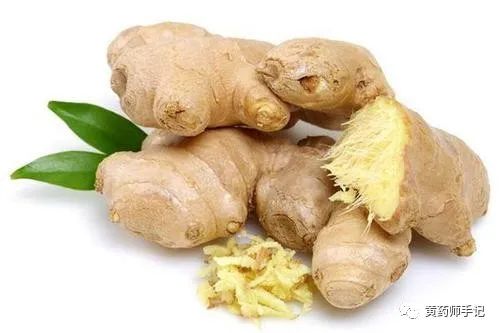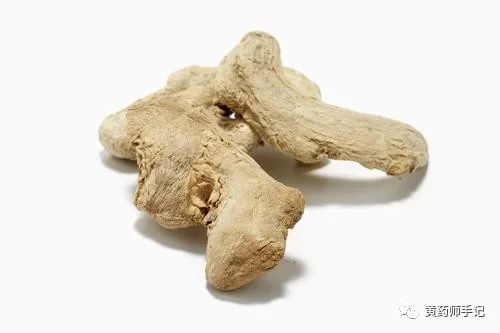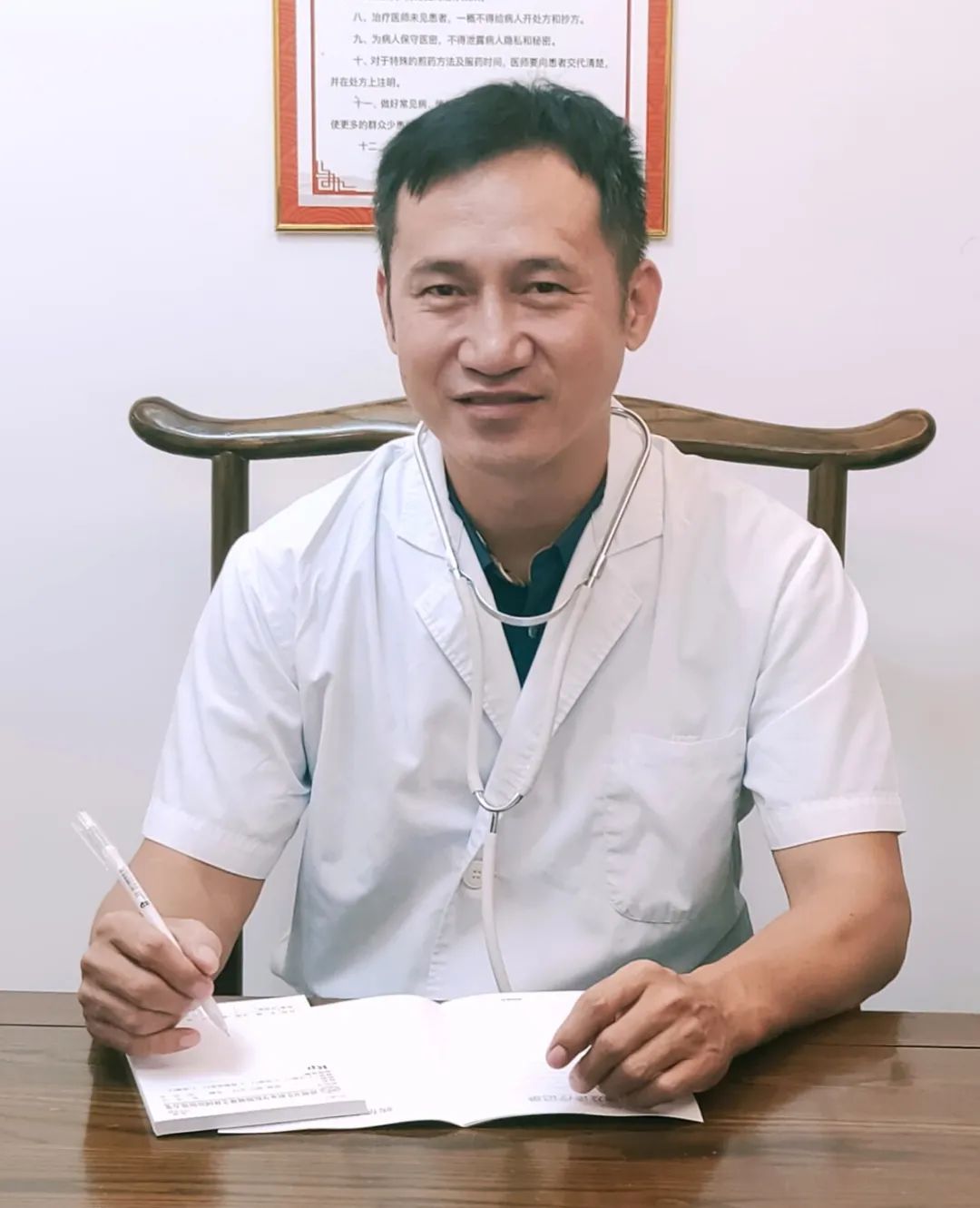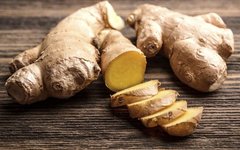Ginger is not only a seasoning but also an important medicinal herb in Traditional Chinese Medicine (TCM). The earliest record of ginger as a medicinal substance is found in the “Shennong Bencao Jing” (Shennong’s Classic of Materia Medica), which states that dried ginger (Gan Jiang) “is used for chest fullness, cough, counterflow of qi, warming the middle, stopping bleeding, inducing sweating, expelling wind-dampness, and treating diarrhea.” However, the effects of fresh ginger (Sheng Jiang) and dried ginger are quite different. This article introduces how TCM utilizes dried and fresh ginger and their distinctions.
干姜 (Gan Jiang)First, we discuss dried ginger. It is first recorded in the “Shennong Bencao Jing”. The effects of dried ginger include warming the middle and dispersing cold, warming yang and unblocking meridians, and warming the lungs to transform phlegm. It is a warming interior medicine commonly used to treat cold pain in the abdomen, cough with cold phlegm, vomiting, diarrhea, and weak pulse with cold limbs.It is often used in combination with Fu Zi (Aconite), with examples including Li Zhong Wan (Regulate the Middle Pill), Fu Zi Li Zhong Wan (Aconite Regulate the Middle Pill), Si Ni Tang (Frigid Extremities Decoction), Xiao Qing Long Tang (Minor Blue Dragon Decoction), and Zhu Che Wan (Stop the Car Pill). Among these, Li Zhong Wan is derived from the “Shang Han Lun” (Treatise on Cold Damage) and contains Ren Shen (Ginseng), Bai Zhu (White Atractylodes), Zhi Gan Cao (Honey-fried Licorice), and Gan Jiang (Dried Ginger). Its effects are to warm the middle and disperse cold, tonifying qi and strengthening the spleen, and it is used for abdominal pain and diarrhea caused by spleen and stomach deficiency with cold.Fu Zi Li Zhong Wan, derived from the “Taiping Huimin Heji Ju Fang” (Formulas for Benefiting the People), adds the very warming Fu Zi, enhancing the warming effect. The original text states, “It treats cold weakness of the spleen and stomach, abdominal cramping pain, vomiting and diarrhea, cholera with cramping, cold body with slight sweating, cold hands and feet, fullness under the heart, rumbling in the abdomen, persistent vomiting, inability to eat, and all cold and stubborn conditions.” In the Ming Dynasty, Zhang Jingyue added symptoms such as abdominal pain after intercourse, cold hands and feet, and cold food causing cold symptoms.Si Ni Tang, also from the “Shang Han Lun”, contains only Fu Zi, Gan Jiang, and Zhi Gan Cao, and is a representative formula for rescuing yang and counterflow. It addresses yang deficiency with impending collapse and cold extremities, and in critical conditions, Si Ni Tang is more effective than wild ginseng.Li Zhong Wan, Fu Zi Li Zhong Wan, and Si Ni Tang all utilize their warming and cold-dispersing properties, while Xiao Qing Long Tang, also from the “Shang Han Lun”, employs Gan Jiang for warming the lungs and transforming phlegm, used for treating exterior wind-cold with internal water and phlegm cough and wheezing.生姜 (Sheng Jiang)Next, we discuss fresh ginger. Fresh ginger is frequently used in the “Shang Han Lun”, and the combination of fresh ginger and jujube is very common. Later physicians, such as Tao Hongjing, recorded in his “Ming Yi Bie Lu” (Record of Famous Physicians) that “Fresh ginger, with a spicy and slightly warm flavor, is used for cold damage, headache, nasal congestion, cough with counterflow of qi, and stopping vomiting.” Compared to dried ginger, fresh ginger has a stronger ability to release the exterior and disperse cold, suitable for wind-cold exterior conditions, while dried ginger is better for warming the interior, suitable for middle jiao spleen and stomach deficiency with cold.Moreover, fresh ginger can also detoxify fish and crab poison and counteract the toxicity of raw Ban Xia (Pinellia). The combination of fresh ginger and Ban Xia is also a classic pairing. The “Jin Gui Yao Lue” (Essential Prescriptions of the Golden Cabinet) states, “Ban Xia and fresh ginger juice are both effective in stopping vomiting, and their combination is even better; they also have the function of opening the appetite and harmonizing the middle. It is used for disharmony of stomach qi, vomiting, and discomfort.”The first formula in the “Shang Han Lun”, Gui Zhi Tang (Cinnamon Twig Decoction), is used for exterior wind-cold and wind evil causing headache, fever, sweating, and aversion to wind, and it uses fresh ginger and jujube.

干姜和生姜的区别 (The Differences Between Dried Ginger and Fresh Ginger)
Many people mistakenly believe that dried ginger is simply sun-dried fresh ginger, and even many TCM practitioners may confuse the two.
In fact, dried ginger is not sun-dried fresh ginger but is made from mature ginger (old ginger).
Fresh ginger grows in the ground, and many new ginger (young ginger) shoots will grow beside it, while the original piece becomes mature ginger, which is very old and very spicy.
The cultivation processes of the two are also different.
Fresh ginger requires frequent earthing up during its cultivation, so it usually grows quickly, with long and tender rhizomes. However, its internal components do not accumulate sufficiently, and even when dried, it is quite light.

Fresh Ginger
Dried ginger, on the other hand, is not earthed up, and the rhizome is directly exposed to the soil surface, so it does not grow further, continuously accumulating internally. When dried, its volume does not decrease much, and it is very dense.

Dried Ginger
干姜热性非常强,比生姜强很多 (Dried Ginger is Much Hotter than Fresh Ginger), which can warm the middle and disperse cold, often paired with Fu Zi to rescue yang and counterflow. There is a saying, “Without dried ginger, Fu Zi cannot be hot,” which shows its warming nature. This is not something that can be achieved by simply sun-drying the fresh ginger we use in cooking.
However, fresh ginger can stop vomiting and disperse wind-cold, thus it is more often used for exterior conditions. Dried ginger is more often used for interior conditions and does not have a significant effect on stopping vomiting.
There is a saying, “Old ginger is spicier.” This old ginger refers to dried ginger. Just like people, the elderly are more stable than the young, with more accumulation, and they are more seasoned in their actions.



中医针灸推拿科:谢一兵 (Department of Acupuncture and Tuina: Xie Yibing)

★ Associate Professor
★ Associate Chief Physician
简介 (Profile)
Graduated from Fujian University of Traditional Chinese Medicine in 1990, with over 30 years of clinical experience.
擅长 (Specialties)
1. TCM specialty in chronic rhinitis and cough: using rhinitis ointment and floating needle therapy to comprehensively treat various acute and chronic rhinitis, allergic rhinitis, and sinusitis. Also treating chronic cough, adenoid hypertrophy, chronic pharyngitis, and asthma.
2. TCM warming acupuncture and Qi guiding: a. Various constitution adjustments: treating women with yang deficiency, cold uterus, cold limbs, menstrual pain, headaches, and infertility; treating qi and blood deficiency leading to fatigue, easy colds, prolonged illness, and hair loss; b. Detoxifying and reducing fat: treating abdominal obesity, primary hypertension (Grade 1 and 2), hyperlipidemia, gout, etc., and treating chronic urticaria, eczema, neurodermatitis, and acne.
3. TCM pediatric tuina: treating pediatric colds, coughs, sore throat, anorexia, food stagnation, enuresis, diarrhea, and torticollis.
4. TCM pain specialty: using rapid effective muscle relaxation and pain relief techniques, floating needles, and buried threads to treat various acute and chronic soft tissue injuries, degenerative changes causing pain, arthritis, spinal diseases, and related visceral dysfunctions. Specializing in treating cervical spondylosis, headaches, dizziness, lumbar disc herniation, lumbar muscle strain, and chronic gastritis with abdominal distension and pain.

【免责声明】 (Disclaimer) The images and text are sourced from the internet, and the copyright belongs to the original author. If there is any infringement, please contact us for removal!
温馨提示 (Friendly Reminder): This platform shares health-related images and information for reference, learning, and communication purposes only, and should not be used as a basis for medical diagnosis. Please consult a physician for guidance if needed.

